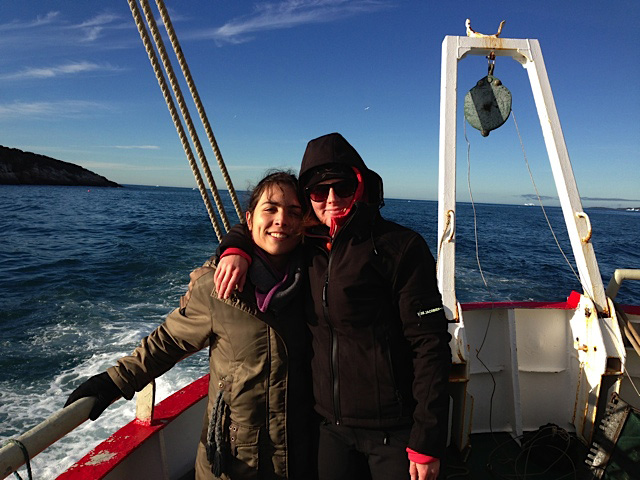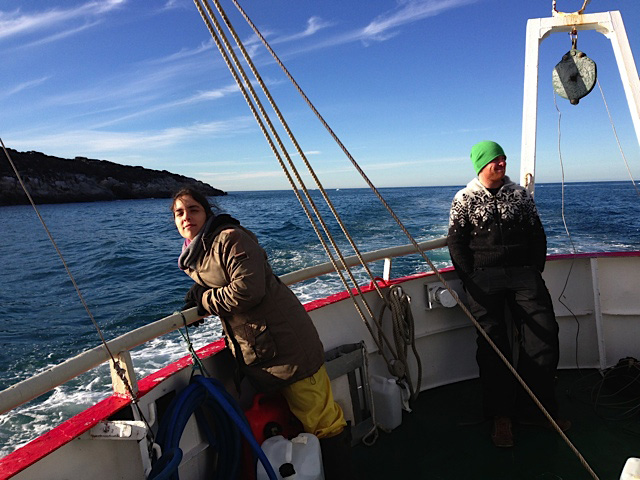Finally!!!!!! Today was the day for the plankton folk to rule the Porsild, and boy did we rule! We set off at the crack of dawn (or around 8 am…). To our surprise breakfast was waiting for us, despite the early hour. Thanks to the troopers Anne Helene and Perpetua, who got up at 6.15 to prepare that for us!
The group that headed out was Peter K., Sandra and Josefin, who were all on the hunt for plankton. But we also brought our super translator, Jakob, and Jeroen had the duty of assisting and entertaining.
At first the weather was looking promising. The sun was shining and the water was calm, however as soon as we came out onto open water the waves got significantly bigger. The mighty captain of Porsild decided that conditions were too rough for our planned destination, and so instead he took us to an alternative spot. As Peter had some specific criteria for catching his beloved pteropods (planktonic snails), we needed to find a spot were the depth was a minimum of approximately 200 m. As some pteropods migrate down during daytime to avoid predators, the plankton net needed to go down to ca. 150 m.
As Josefin had only recently learnt that the water hose on board collected its water from 3 m depth, her surface phytoplankton samples were extremely easy to obtain!!! She could simply put her Barbie-sized phytoplankton net under the hose and filter out the plankton.
At the spot, the big zooplankton net was thrown over board and hauled at 150 m for a good while. Peter was full of joy and high hopes for his samples. The excitement was building up as the net surfaced, but…as it was pulled back on board the boat, Peter noticed that the collecting bottle attached to the bottom of the net had been smashed into pieces!!! Despite Peter hiding behind his sunglasses we could tell that the tears were building up. Jeroen stepped in and calmed him down by whispering comforting words in his ear. Søren, our boatman, then suddenly appeared from the cabin holding a big role of duct tape. We could all feel the hope beginning to return. Peter wiped away his tears and stepped into the cabin. He duct taped the life out of the small bottle, and back into the water it went. As always, third time is a charm, and Peter could finally retrieve his pteropods. Søren received a massive big hug from the overjoyed Peter. In the catch there were the expected two species, namely Limacina helicina and juveniles of its specific predator Clione limacina. Generally pteropods have attracted special interest being among the species that are considered to suffer most from increasing ocean acidification, but still little is known about their phylogeny and evolution…
Next up was Sandra. Sandra wanted to retrieve zooplankton samples from 25 m depth. Although our quick-mouthed and cheeky friend had been surprisingly quiet during the rough ride, it was now her time to shine. She quickly returned the zooplankton net into the water and gave strict instructions on the depth and length of the tow. As Josefin had buttered up the captain with pieces of chocolate, he was finally willing to follow the strict orders, marvellously translated by Jakob. In the end Sandra got the samples she needed without having any further problems.
Last but not least, Josefin needed to collect phytoplankton samples from 40 m depth. This was carried out with the help of diligent Søren and… a water sampler! The 60 litres of water that were collected, were then concentrated to a mere volume of 15 ml!!
On our way back to the harbour winds and waves had picked up. Since Jakob had almost accidently dropped Peter’s samples back into the ocean, Peter was now guarding his buckets of planktonic treasures. He set up camp with a minimum of 1 m radius, which no man was allowed to pass. Unfortunately he had forgotten to bring lids, so for the last minutes of the cruise he had to hold the buckets in his hands to prevent the content from being spilled over the deck.

Peter and the Plankton
After 3 hours we arrived back at the harbor without any further incidents. All in all, the trip was extremely successful.
Written by: Josefin (Gothenburg University) and Peter (Bavarian State Collection of Zoology)
Featured image: Clione limacina – commonly known as ”Sea Angel” (photo: Peter Kohnert)



